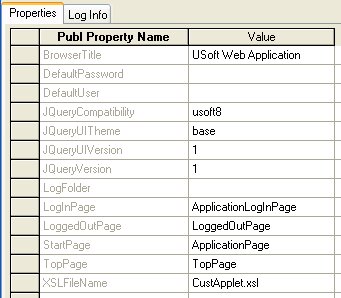|
See
Also
A publication configuration
has a number of system-defined publication properties. These
properties are automatically created when defining a publication
configuration. They are listed on the Properties tab page in the
Publication Configuration window. You can change their values, but
you cannot change the property names or delete them.

When pages are published,
these properties are substituted in published files. The
system-defined publication properties are:
|
·
|
The BrowserTitle
property specifies the title that is displayed at the top left of
the browser when using the Web application. The default value is
USoft Web Application. |
|
·
|
The optional DefaultUser property specifies the user
who gets access to the generated web pages by default. The
credentials provided here and for the DefaultPassword property are
used to log on automatically to pages for which the Logon Required
property has been set to Yes. The use of
DefaultUser/DefaultPassword ensures that the application will not
display login dialogs. |
|
·
|
The optional DefaultPassword property is the
password for this default user. |
|
·
|
The JQueryCompatibility
property handles compatibility issues with earlier versions of Web
Designer applications. When set to 'usoft7' buttons have the same
appearance as USoft7 Web applications. All other values display
buttons in the latest jQuery style. |
|
·
|
The JQueryUITheme
publication property specifies the theme that is used to display
jQuery UI objects. Possible values of the property are: |
|
·
|
none: no jQuery UI is included |
|
·
|
base (this is the default) |
|
·
|
The JQueryUIVersion
publication property specifies the jQuery user interface (UI)
version that is included in the Web page. The default is '1'.
Specifying only part of a three digit version number means that the
latest version of what is specified will be used (e.g. 1.8 loads
1.8.5). |
|
·
|
The JQueryVersion
publication property specifies the jQuery version that is included
in the Web page. The default is '1'. Specifying only part of a
three digit version number means that the latest version of what is
specified will be used (e.g. 1.2 loads 1.2.6). Examples of possible
values of the properties are: |
Local refers to the js/jquery.js file
in the publication folder.
|
·
|
The optional LogFolder
property specifies the default Logging Folder. If a value is not
specified for this property (default), logging will be to the
<publication_folder>/logs folder. |
|
·
|
The LogInPage property
specifies the Login page. The default is the ApplicationLogInPage
page. |
|
·
|
The LoggedOutPage
property specifies the default page shown when an end user has
logged out from the web application. The default is the
LoggedOutPage page. |
|
·
|
The StartPage property
specifies the page that end users see once they are logged in into
the web application. The default is the ApplicationPage page. |
NOTE:
Run-time, you can overrule the
value for the StartPage property by adding the following parameter
to the URL in the Address bar of your browser:
?$StartPage
|
·
|
The TopPage property is
used to specify the default TopPage for your application. This must
be a page for which the Top Page property has been set to Yes at
page level. See The Top Page for
more information. |
|
·
|
The XSLFileName
property specifies the XSL file that is used to transform the
respective Combined XML file. The default is CustApplet.xsl |
|

